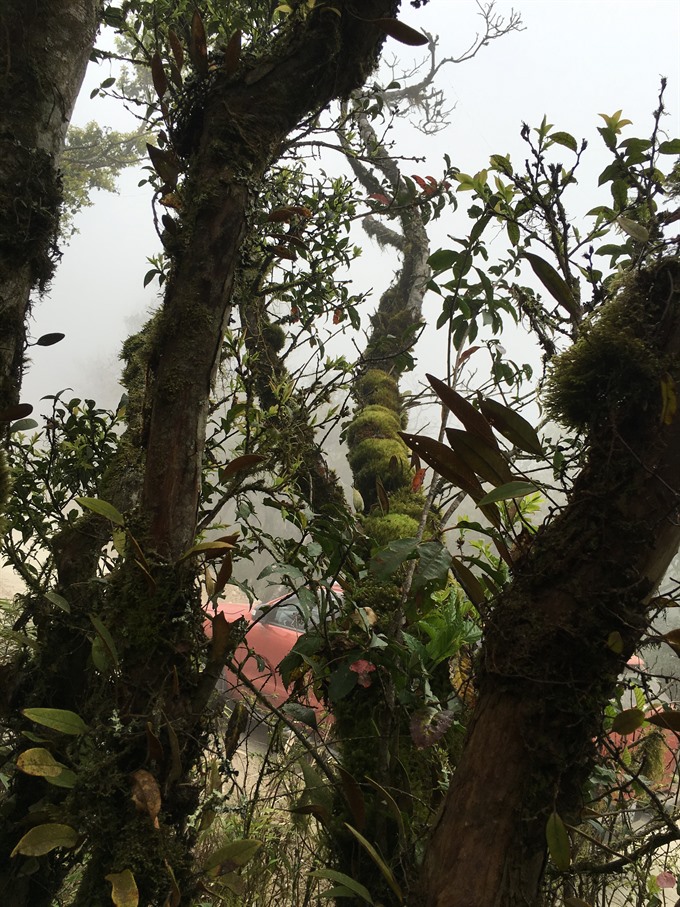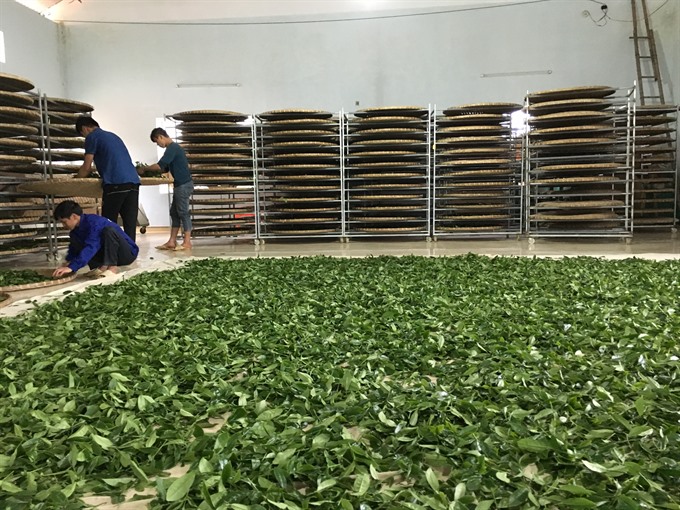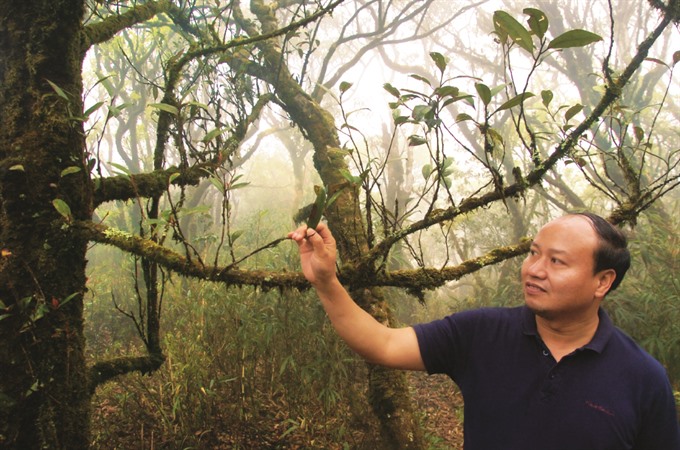Viet Nam News
The Land of Heaven, as the Phia Oac-Phia Den area in Cao Bang Province was once known before a descent into relative obscurity, is staging a comeback via offshoots of centuries-old tea trees. Do Doan Hoang has the story.
To paraphrase a famous saying, to know Phia Oac-Phia Den is to love her.
It is thus that I hold deep affection for each mountain pass, village and community in Cao Bang Province, and this deepens perceptibly when it comes to the Phia Oac-Phia Den area.
With a climate that seems to have four seasons in a single day, the area has invited comparisons with renowned resorts in Viet Nam like Sa Pa, Tam Dao and Da Lat, but the fact that it is lesser known lends it a different charm.
A favourite resort of the French colonists a century ago, Phia Oac-Phia Den, has been, in relative terms, deserted for over 70 years. Remnants of beautiful French-style villas and other buildings covered in moss are like sleeping beauties waiting to be woken up.
One person doing his bit to nudge them awake is a man I have been “following” for several years via media reports about his passion for ancient tea trees in the high mountains of Nguyen Binh District.
 |
| Heavenly hills: The economic and tourism potential of Nguyen Binh District has been awakened thanks to fresh tea products. VNS Photo Do Doan Hoang |
Hoang Manh Ngoc, an ethnic Dao man in his mid-forties, has protected dozens of hectares of tea in Phia Oac-Phia Den to create a trademark for high quality produce that is distributed nationwide and exported to foreign markets.
Ngoc is a native of the mountainous district , home to renowned Phia Oac Peak. Justifiably proud of its misty winters and cool summers, he had long aspired to do something to preserve the ancient pine forest and majestic villas.
At a time when the district was struggling, Ngoc took the risk of establishing his own construction company to build roads and some homes. After saving a little bit, he thought of starting a business making fresh food and medicines to create jobs for local residents.
The Kolia Company sought to exploit the area’s ecotourism potential, while producing fresh tea and the Cao Bang cassava vermicelli or glass noodle. Modern technique was infused into the traditional methods of the Dao people to harvest tea of high quality with a distinctive flavour that would meet international standards.
 |
| Rustic roots: An ancient tree that dates up to a century old on Phia Den Mountain. VNS Photo Do Doan Hoang |
Taste of the mountains
The Phia Oac Range, with its highest peak at more than 2,000m above sea level, has been recognised as a precious natural reserve with an area of 25,000 hectares.
Misty all year around, the mountain boasts the ecosystem of a cloudy forest with lots of flowers, especially the Rhododendron, which is in full blossom during spring.
Phia Oac also contains the headwaters of many big rivers in the northeast of the country, and it is a huge source of minerals that used to be exploited during the French colonial time.
What makes the area special is that it still has many old, huge tea trees tended to by the Dao Do, Dao Tien and Nung ethnic minorities.
Ngoc used to spend several days visiting these tea gardens and fell for the taste of the tea, flavoured by the mist and minerals of the mountains, that impresses at first sip and leaves a lingering sweet, acrid taste.
The very first time Ngoc enjoyed the subtle and distinctive taste of the local tea, he was moved to preserve the ancient tea trees, protecting the vast area and producing tea for domestic and foreign markets.
 |
| Lots of leaves: On average, Kolia company produces about one tonne of dried tea per day. However, the market demand for Phia Den tea continues to exceed its supply. VNS Photo Do Doan Hoang |
Ngoc travelled to Taiwan several times to study their tea industry and invited specialists to visit each ethnic household in the area and study the old tea trees.
“The specialists and tea masters from Taiwan were astonished on discovering that the mountain range in Phia Oac-Phia Den seemed to be naturally created for tea planting. The natural conditions were so perfect. The temperature during the day never exceeded 22oC, dropping to 15-17oC at night.
“The plants are covered by fog all year round. Sometimes the rainy clouds open up to refresh both people and nature. The height of the mountain is perfect for growing Chinese Ba Xian (Eight Immortals) and Oolong tea species.
“Furthermore, the fresh tea of Phia Oac-Phia Den rarely suffers the equatorial climate of the renowned tea planting area in Taiwan,” Ngoc said.
Ngoc began learning the Dao people’s traditional method of exposing the tea leaves to the frost, and applying ten different kinds of organic fertilisers to as many varieties of tea trees. At the same time, he imported the Oolong, Ba Xian, Longjing and Bai Jiguan tea varieties to cultivate on the Phia Den Mountain.
Ngoc also signed contracts to buy all the tea produced by local households and employed locals with the experience. International specialists were invited to train locals to apply international organic and VietGAP (Vietnamese Good Agricultural Practices) standards in producing high quality tea.
The first consignment of tea exported to Taiwan in 2013 was a great success, fetching prices ranging from two to six million dong (US$90-260) per kilo and receiving positive feedback from buyers. The Dao were very happy to harvest the first profits from tea trees that had been in their community for generations.
 |
| Passionate vision: Director Ngoc stands next to an ancient tea on Phia Oac Mountain. VNS Photo Do Doan Hoang |
After six years of developing the tea business, Ngoc once again took the plunge, spending dozens of billions of dong to expand his factory to over 400sq.m and purchase modern equipment to be installed right on top of the Phia Den Mountain, increasing its capacity to one tonne of dried tea per day. However, the market demand for Phia Den tea continued to exceed its supply.
Participating in many domestic and international trade fairs only increased Ngoc’s determination to follow the path of producing high quality tea. He expects Kolia to be growing tea on more than 200 hectares by 2020.
The impact
One time, Ngoc took me to visit the Vong Tien Cung Temple that was built hundreds of years ago and recently restored by him as a sign of respect to the area’s history. During this visit, he also introduced me to some tea producing households.
Trieu Van Ngan owns about 6,000 Phuc Van Tien tea trees. His family used to be very poor despite years of nurturing the trees until Kolia taught them new methods by bringing in tea specialists and introducing international standards for organic tea.
“We can now harvest better tea with less hardship. And we are proud to provide the market with tea products totally free of pesticides,” Ngan said, adding that the income of local tea workers has increased four times since applying modern methods.
Now, in the dreamy foggy atmosphere of the Phia Oac-Phia Den Mountain that is covered with the evergreen colour of the vast tea farms, Ngoc and his partners have embarked on an ecotourism project, reviving it as a tourist destination.
Visitors can enjoy the taste of the forests and mountains, from fresh food to fruits and tea produced by locals.
After decades lost in beauty sleep, Phia Oac-Phia Den has woken up, thanks to a Dao man dedicated to his hometown, and is set to become a new hotspot for visitors. VNS